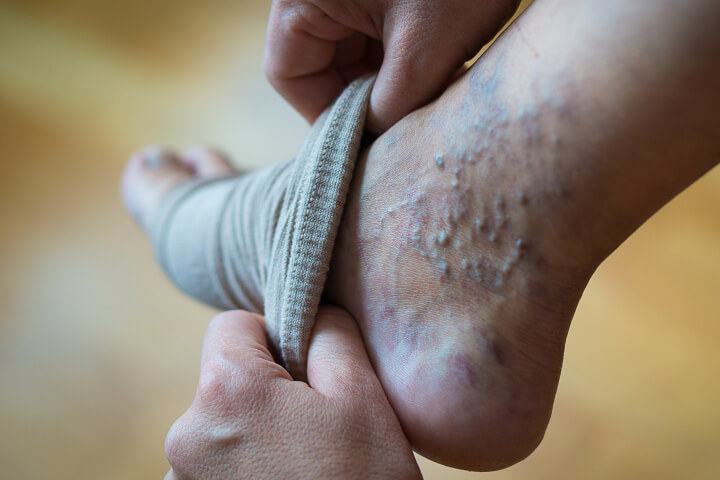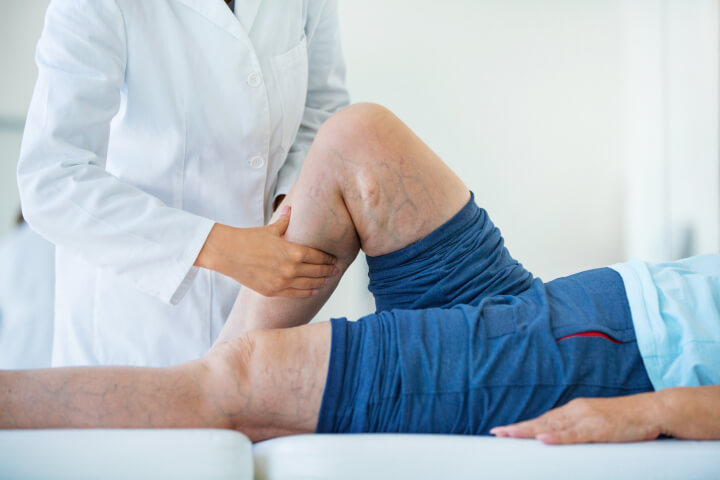Spider veins are mostly harmless and cause little to no pain. However, people with spider veins can feel insecure about how it affects the appearance of their legs and face. That’s why there are several treatments available for reducing the appearance of spider veins.One of these treatments is sclerotherapy, more commonly known as spider vein injections. Through multiple injections, it can reduce the appearance of damaged veins and give you even, clearer skin.
So how many injections does it take to get rid of spider veins? For most patients, it can take up to four injections to see your desired results. Treatment sessions can take anywhere from 15 minutes up to one hour, and the entire treatment can take up to six weeks. You can get your injection from a dermatologist, vein specialist, plastic surgeon, or cosmetic surgeon.
Learn More: Massage Therapy for Spider Veins: Is It Really Effective?
How many injections you need can depend on the size of the treated vein or veins. For most patients, it can take up to four injections to see your desired results. Treatment sessions can take anywhere from 15 minutes up to one hour, and the entire treatment can take up to six weeks. You can get your injection from a dermatologist, vein specialist, plastic surgeon, or cosmetic surgeon.
Sclerotherapy is a safe and minimally invasive procedure that treats both varicose veins and spider veins. Your doctor will inject a sclerosing agent, which may be any of the three: polidocanol, sodium tetradecyl sulfate, or hypertonic saline solutions. When injected into your damaged vein, it will seal the vein wall shut.
As a result, the flow of blood is diverted towards other veins. Since the targeted vein is no longer in use, your body will slowly begin to reabsorb the vein, reducing its prominent appearance on your skin. Every follow-up injection makes it less visible until you no longer see your spider veins. This can take up to four injections.
After every injection, you may feel a bit of cramping, stinging, or burning sensation in the target vein. It can also feel more painful if the sclerosing agent leaks into surrounding tissues, but getting your treatment from an experienced specialist can minimize the risk of this happening.
Aside from the sclerosing agent, the injection itself can cause minimal pain and common side effects such as:
These are side effects common from getting injections. Most of these symptoms can go away after a few days, while bruising may take up to 2 weeks to fully heal. You can use over-the-counter pain relievers to treat the pain, but avoid anti-inflammatory painkillers like aspirin and ibuprofen, as they’re blood thinners that can affect your blood clotting and promote bruising.
There may also be brown lines or brown spots that appear as scar tissue in the treatment area. Some disappear after six months, while others may experience this last for much longer. Having an experienced sclerotherapy provider can reduce the risk of this happening.
During your initial consultation, your provider should check your medical history to see if you are fit to receive sclerotherapy treatments. In case of allergic reactions, seek immediate medical care.
There’s only minimal downtime after sclerotherapy, so you can resume your normal activities after your injection. However, avoid hot baths, prolonged sun exposure, and strenuous exercises up to two days after your injection, as this can affect blood flow and cause bruising. You may be advised to wear compression socks or stocking to help with the process.
Spider veins are small damaged veins that normally appear on your legs or face. On your face, spider veins form due to blood vessels bursting due to pressure or sun damage. For the legs, it’s usually caused by weak or damaged valves that cause blood pools in certain areas, resulting in a bulging vein that appears on your skin.
While these aren’t physically harmful, unsightly spider veins can be very visible on your skin. They can be removed through processes like sclerotherapy, but the treatment is more for cosmetic purposes than any medical benefits.
Spider veins are most common in people who have the following factors:
Read More: How Many Laser Treatments Are Needed to Remove Spider Veins?
Spider veins and varicose veins are both forms of a venous disease (having weakened or damaged valves in your veins that causes blood to pool and appear on your skin), and while they may look similar, it’s important to tell the difference between the two to get the right treatment from it.
Spider veins are small and thin lines that can appear as blue, red, or purple. These usually occur in superficial veins, while varicose veins may affect deeper veins in your skin. A few spider veins can feel mildly painful, but spider veins are mostly painless. There are no medical risks associated with spider veins and are treated for cosmetic purposes.
Varicose veins, on the other hand, have a deeper and larger vein that can appear as red or flesh-colored lumps on your legs. Varicose veins can cause more acute pain, as well as itching, bleeding, and swelling. Varicose veins also have a medical risk of blood clots and circulation problems, so it should be treated more seriously.

Aside from sclerotherapy, there are several other treatments you can consider to treat spider veins. Talk to a vein specialist to learn more about which method can work best for you.
These compress your lower legs to improve blood flow, which can prevent any future spider or varicose veins. Support pantyhose and gradient compression stockings and socks are available in vein specialist centers, pharmacies, or online. These can give a light to medium compression pressure on your lower legs, feet, ankles, and calves.
Your doctor may also recommend prescription compression stockings which apply the most pressure to your feet and legs. These are not suitable for people with cardiovascular problems, so you will need a prescription to use this for your spider veins.
This is similar to sclerotherapy, but the difference is what is injected into your vein. While sclerotherapy injects a sclerosing agent, closure system treatment injects a sticky substance to block the vein.Just like sclerotherapy, the appearance of the damaged vein will eventually fade.
Aesthetic centers can use laser therapy to reduce the appearance of spider veins if the blood vessel is small and close to the skin’s surface. During the procedure, a laser will target heat energy onto the target vein. This will cause it to clot and dry up.

Having visible veins on your legs and face can affect how you see yourself. Fortunately, spider vein injections can take only an average of 6 weeks to get the results you want. For minimally-invasive treatments that can help you reclaim your confidence from spider veins, get your sclerotherapy injections from a vein doctor you can trust.
Vein Center Doctor is the top vein care clinic in New York and New Jersey. We offer outpatient vein treatment services for spider veins and varicose veins, producing high success results. Contact us today to schedule a free consultation.
Most Insurance is accepted for treatment